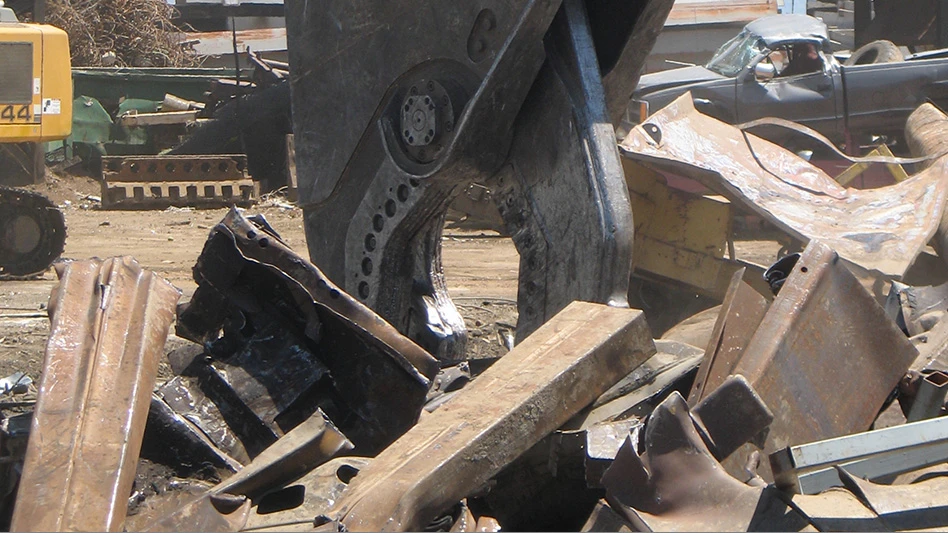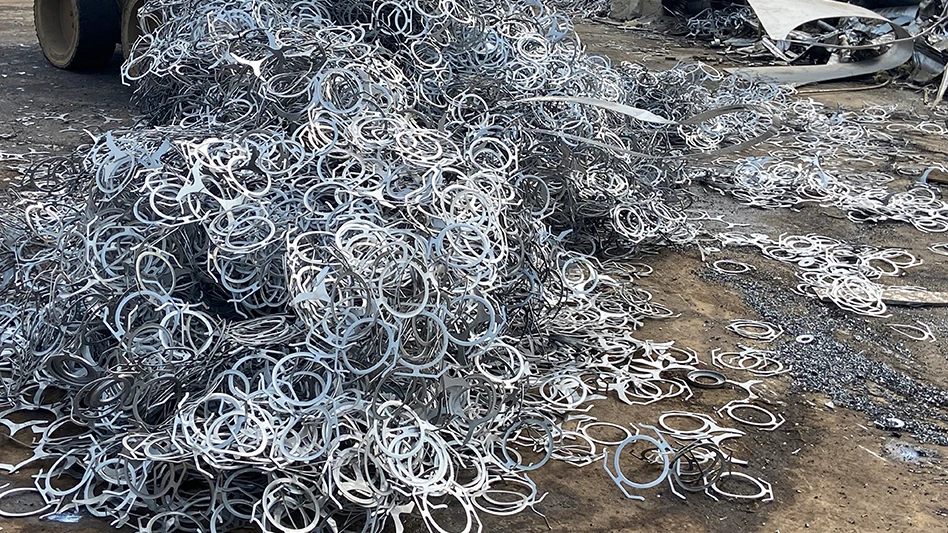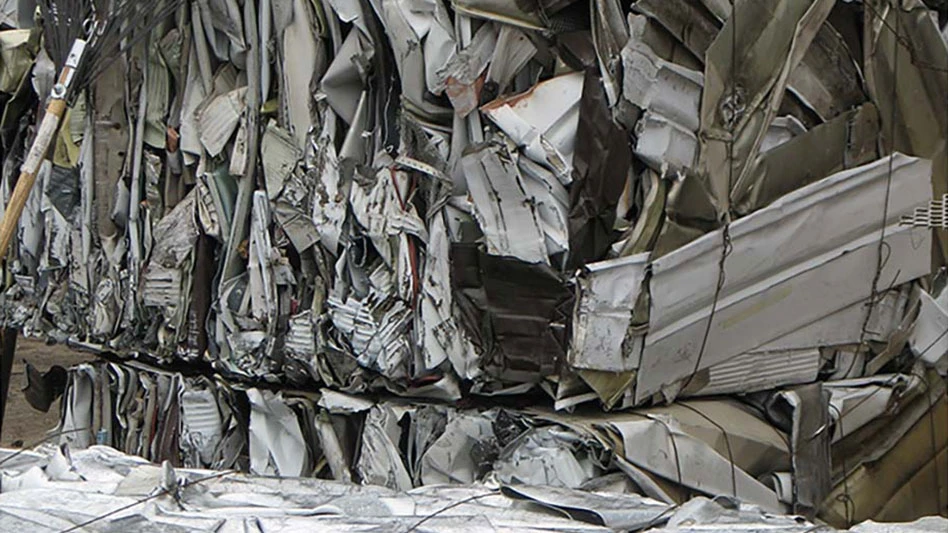|
1958 1968 1980 1989 1989 2001 2007 2007 2013 |
When the publication that would become Recycling Today was founded as Secondary Raw Materials in 1963, industrial scrap recycling markets in the U.S. were well-established for metals, cardboard and several other materials.
Over the next 50 years, these markets would go through significant changes and relocations. Some U.S. consuming markets grew but shifted geographically. Others peaked at some point during the stretch, and, as the U.S. produced a large scrap surplus for many materials, consuming markets subsequently became more global.
Technology, investment cycles, off-shoring and the changing habits of America’s household consumer sector have all affected how the scrap that is collected is ultimately melted, pulped or otherwise turned into a new product.
A Challenge to Iron Giants
In 1963, America’s steel industry was dominated by a handful of companies with legacies that traced back to the business titans of the 19th century.
Scrap processors in some cities had the option of preparing scrap grades for iron and steel foundries in their regions, and processors near the Atlantic and Pacific coasts could prepare shipments for export.
But much of the scrap collected and baled or sheared would head to the large, integrated steelmaking complexes run by companies such as United States Steel Corp., Bethlehem Steel, Republic Steel, National Steel and Jones & Loughlin (J&L).
These companies had a particularly strong presence in the Mid-Atlantic and Great Lakes regions, along with the Ford Motor Co.’s in-house steelmaking complex near Detroit and Armco Steel mills in Ohio and Kentucky. Scrap processors in the Northeast and Midwest could sell their scrap to these mills or to brokers serving these mills and enjoy relatively low freight costs and easy freight arrangements.
In the West and South, large steelmaking complexes were fewer but included the Kaiser Steel Corp. complex in Fontana, Calif.; Geneva Steel in Utah; the U.S. Steel Corp. mill in Bessemer, Ala., near Birmingham; the Armco steel mill near Houston; and, by 1970, a U.S. Steel Corp. mill near Houston. Scrap processors in the West and South, if seeking alternatives, would prepare grades for foundries or explore the export markets.
Although integrated steel mills with blast furnaces consumed considerable amounts of scrap, scrap was a minor ingredient in the average melt, perhaps consisting of from 10 to 20 percent of the charge.
Change started arriving to the flow of domestic ferrous scrap with the installation of an electric arc furnace (EAF) steel melt shop in Darlington, S.C., in 1968. It was by no means the first EAF mill in the world or even in the United States. But the company that built this “minimill,” Nucor Corp., based in Charlotte, N.C., had giant plans.
CEO F. Kenneth Iverson took an approach to steelmaking that largely bypassed the need for iron ore and coking coal and instead relied on iron and steel scrap as the primary feedstock.
Skeptics saw limitations in the steelmaking process, but Iverson and Nucor pushed for innovations that expanded the boundaries of EAF steelmaking into new processes (such as continuous casting) and new grades and types of steel.
Nucor alone installed significant EAF mill capacity in the 1970s, 1980s and 1990s and the company was soon joined by several other firms that changed the face of the steelmaking industry in the U.S.
Ferrous scrap increasingly began flowing south, as Nucor and competitors, such as Commercial Metals Co.’s SMI Steel, Birmingham Steel Corp., Ameristeel and Chaparral Steel, began buying ferrous scrap in volume to feed mills in the region.
Other parts of the country were not left out of the minimill boom, as Nucor and its rival Steel Dynamics Inc., Fort Wayne, Ind., built mills in Indiana; traditional integrated steelmakers diversified by building EAF capacity in Pennsylvania and Ohio; North Star Steel, a division of Cargill, invested in minimills in Minnesota and Ohio; and Co-Steel built EAF mills in New Jersey. These new mills provided domestic outlets for ferrous scrap in the Midwest and Northeast.
West of the Rocky Mountains, Schnitzer Steel Industries Inc. invested in EAF capacity in Oregon; TAMCO built a sizable EAF mill in Rancho Cucamonga, Calif.; and Nucor Corp. established outposts in Kingman, Ariz., and Plymouth, Utah.
The EAF steelmaking revolution was swift and significant. During Recycling Today’s 50 years of publishing, the presence of scrap-fed EAF steelmaking has risen from a 4 percent share of the U.S. market in 1963 to a 60 percent share in 2011.
By the time Iverson stepped down as CEO of Nucor Corp. in 1995, the company was operating several EAF mills and was on its way to becoming America’s largest steelmaker. As well, its success had spawned a number of competitors, each of which opened mills hungry for ferrous scrap.
For ferrous scrap processors, the growth of the EAF sector has helped ensure domestic markets for scrap even during economic down cycles. Relationships with mills can still be antagonistic and pricing volatility remains a factor, but the two industries have increasingly worked in step on issues such as quality and safety.
 |
A Diffrerent World
Globalization has given manufacturers the ability to build supply chains that reach half-way around the world and back. The merits and downsides to the global economy provide topics for 300-page books and the topic of nonferrous metals production in the U.S. in the past 30 years would provide a suitable chapter for such a book.
In the early 1960s, nonferrous scrap dealers and brokers could ship their red metals to a variety of brass mills, secondary smelters and refiners. Larry Sax, who began working full-time for his family’s Boston nonferrous scrap firm J. Sax & Co. in 1958, says at that time New England was considered “brass alley” because of the number of brass mills located there.
As metals producers consolidated and often moved their mills or smelters to other states or countries, nonferrous dealers and traders adjusted to survive.
Each of these segments has experienced down cycles, consolidation and competition from overseas. Sax estimates that there may have been as many as 90 secondary nonferrous ingot makers when that industry sector was at its peak, but their number is down to 12 or fewer in 2013.
U.S.-based secondary copper smelters and refineries have been through a process of near extinction in the past 50 years.
The U.S. Geological Survey (USGS) and its predecessor government agencies have maintained copper production statistics for the U.S. dating back to 1900.
The production of secondary copper was first recorded in 1906, at just 12,000 tons. Economic cycles are clear to see when examining how this annual figure grew (in most cases) or receded, as it did in the early 1930s.
Secondary copper production in the U.S. peaked in 1980 at 613,000 tons. Production figures trended somewhat downward in the 1980s but experienced a dramatic decline from 1993 to 2006 despite the state of the U.S. economy.
A factor in the decline, according to coverage in Recycling Today and other publications, was U.S. Environmental Protection Agency (EPA) scrutiny of the secondary copper refining and smelting processes.
When the Chemetco Inc. secondary smelter in Hartford, Ill., closed in 2001, it marked the end of large-scale secondary copper smelting in the United States.
The shutting down of this sector caused overall U.S. secondary red metals production to plummet from its peak of more than 600,000 tons in 1980 to just 151,000 tons in 2006.
Production has stayed in the 138,000 to 158,000 tons range, with brass mills and a handful of ingot makers among the remaining domestic consumers.
With domestic destinations dramatically reduced, red metals processors and traders became even more familiar with export markets. As U.S. secondary copper production was shrinking, the red metals industry in China was ramping up as that nation woke up from several decades of isolation and economic stagnation.
Initially, recyclers in California and nearby states benefitted from the surging demand in China, as it soon became a much better logistical proposition to export red metal scrap rather than send it via sometimes expensive rail or truck journeys to other parts of the U.S.
According to the Washington, D.C.-based Institute of Scrap Recycling Industries Inc. (ISRI), while China purchased $165 million red metal scrap from the U.S. in 2000, by 2011 that figured had soared to $3.5 billion. The global shift in copper production has been one of many factors that have changed the way the nonferrous scrap sector operates.
 |
Rotating Cast of Characters
The cast of consumers for aluminum scrap also has changed greatly during the past five decades. Among the company names that once figured prominently as buyers of aluminum scrap were secondary producers U.S. Reduction, Wabash Alloys, IMCO Recycling and Commonwealth Industries.
Many of the secondary smelters that had been operated by these companies are now part of Aleris International Inc., based in the Cleveland area.
Wabash Alloys traced its secondary smelting roots to the creation of a specification alloys ingot plant in Wabash, Ind., in 1958. By the late 1990s, when the company was profiled by Recycling Today, Wabash Alloys had acquired four former U.S. Reduction facilities to give it a total of nine secondary smelters in the U.S., one in Canada and one in Mexico. Wabash was acquired by Aleris in 2007, and by that time Aleris already included the IMCO and Commonwealth facilities in its portfolio.
Alcoa has endured as a primary aluminum producer that purchases scrap, but other names have faded from the scene, including Reynolds Metals Co., Alcan and Pechiney SA.
France-based Pechiney was purchased by Montreal-based Alcan in 2003. Four years later, Alcan merged with mining company Rio Tinto and spun off its used beverage container (UBC)-consuming smelters as Novelis. Subsequently, Novelis has been purchased by India-based conglomerate Aditya Birla, though it still operates under the Novelis name.
Throughout much of Recycling Today’s history, Reynolds Metals Co. was a significant force in the aluminum industry in the U.S. In 1991, the company employed more than 30,000 people globally and operated some 60 facilities in the U.S. alone.
Reynolds Metals merged into Alcoa in 2000. As of 2013, the Reynolds Wrap line of foil products lives on, produced and distributed by Reynolds Group Holdings, based in New Zealand.
Although the signs at the gates of the smelting plants in the U.S. have changed, many grades of aluminum scrap continue to head to the same destinations in 2013 as they did in preceding decades.
As auto shredders became the preferred method of processing scrapped vehicles, however, recyclers who had traditionally focused on scrap iron and steel have found themselves producing and trading considerable amounts of zorba, twitch and other shredded aluminum grades. These grades have headed either to heavy media plants in the U.S. for further separation or to China where they are (most often) hand-sorted before being smelted.
 |
A Bigger Forest
Paper recycling advocates like to refer to all the scrap paper generated within a population center as an urban forest.
In the early 1960s, the urban forest had established itself as a supplier of reliable secondary raw materials and as a way to make a living for those who could collect and ship scrap paper.
To a great extent, though, only a small percentage of paper mills were really tapping into this resource, and they were largely seeking only a handful of grades.
Makers of corrugated and boxboard grades with mills in or near urban areas were among these “early adopters,” as the quality and cost-effectiveness of using recovered fiber quickly became apparent.
Newark Recycled Paperboard Solutions, Cranford, N.J., (long known as The Newark Group), traces its production of recycled-content board back to 1912. The company now operates six recycled-content paperboard mills, including mills in Los Angeles, Milwaukee and Mobile, Ala.
“Makers of boxboard, especially in urban areas, also have long been traditional consumers of recovered fiber,” says Bill Moore of paper and recycling industry consultancy Moore & Associates, Atlanta.
In 1963, however, most of America’s high-volume paper mills were situated in the forested regions of Wisconsin, Maine, Georgia, Oregon and other states with thriving timber sectors.
An environmental movement that started in the 1960s and 1970s provided a voice to advocates for resource conservation, recycling, landfill diversion and the protection of forests and animal species in unsettled areas. Legislators and government agencies, responding to these concerns, introduced a number of acts and executive orders that boosted paper recycling and collections. As a result, the newsprint and graphic (printing and writing) paper sectors found themselves working increasingly higher percentages of recycled fiber into their furnish.
In 1989, California passed a recycled newsprint act (Assembly Bill 1305) that required newsprint users (primarily newspapers) to use 25-percent-recycled-content paper immediately and 50-percent-recycled-content paper by 2000.
Ten years later, in 1999, the California Integrated Waste Management Board reported that 86 percent of newspaper companies filing with the Waste Board certified using at least 40-percent-recycled-content newsprint, compared with 75 percent of newspapers in 1996. Together, the newspaper publishers consumed 1.1 million metric tons of recycled-content newsprint in 1999, about 64 percent of all the newsprint used in the state.
Moore says California was one “of about a dozen” states that enacted recycled-content laws for newsprint or for the printing and writing paper used by stage agencies. The laws coincided with the increased sourcing of recovered fiber from curbside collection programs rolled out in cities across the United States.
Recovered fiber now accounts for 37 percent of raw materials used at paper mills in the United States. According to the American Forest & Paper Association (AF&PA), Washington, D. C., as of 2013 some 76 percent of U.S. paper mills use recovered fiber and 113 mills rely on it as their sole raw material.

Explore the July 2013 Anniversary Issue
Check out more from this issue and find your next story to read.
Latest from Recycling Today
- Volvo CE dealership in Canada changes hands
- Takeuchi adds Southwestern US manager
- McNeilus unveils fully integrated, electric front-loading collection vehicle
- CalRecycle releases SB 54 updates as new year begins
- Regenx receives funding from the National Research Council of Canada Industrial Research Assistance Program
- GFL Environmental Inc. to sell majority stake in Environmental Services business to Apollo, BC Partners
- SPR launches automated bifacial solar panel recycling line
- MBA Polymers UK offers ABS to global market





